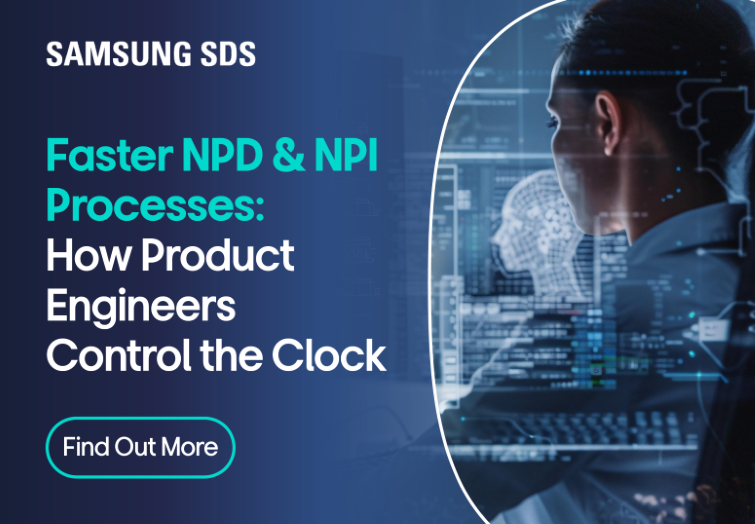.png?queryString=20251023044815)
In product development, time isn’t just money. It’s competitiveness. The design phase is where the timeline starts ticking, and efficiency here determines whether you stay on track or risk delays that ripple across sourcing, production, and launch.
As a product engineer, your KPIs go beyond getting the design done. You’re under pressure for first-time-right success, fewer iterations, and faster prototyping-to-production cycles. The pace of NPI and NPD starts with you, and the way you work determines whether your company beats competitors to the market or falls behind.
How can you take control of the clock? Design-to-source.
Speed Isn’t Just a Metric
Speed isn’t optional. It’s the difference between being first to capitalize on demand or scrambling to catch up. When products launch sooner, your company captures revenue earlier, shapes customer expectations, and stays ahead of competitors chasing the same opportunity.
For you, the benefits are even more immediate. Getting it right the first time means fewer late nights, more professional recognition, and the freedom to focus on innovation instead of putting out fires.
And speed isn’t just about dates on a project plan. It’s about delivering products that work as intended, meet cost targets, and clear quality standards under pressure. When you move quickly and confidently, you set the pace for the entire NPD and NPI process, proving that engineering is where competitive advantage really begins.
What’s Really Slowing You Down?
When speed is the goal, the reality can feel like jumping into a race that started yesterday. It’s not the design work itself that eats up the most time, it’s the hurdles in the way.
Endless iteration loops appear when supplier input comes too late. BOM disruptions derail progress with compliance gaps, substitutions, price changes, or shortages you didn’t see coming. Then there’s the grind of tracking down data across siloed systems or manually checking details that should already be aligned.
On top of that, you’re never working alone. Every project requires coordination with procurement, compliance, suppliers, R&D, and contract manufacturers. When these groups aren’t moving in sync, the obstacles multiply and progress slows to a crawl.
The BOM: Your Make-Or-Break Collaboration Tool
When time is on the line, nothing creates delays faster than a disconnected bill of materials (BOM). If design, procurement, and suppliers are working from different versions, changes slip through the cracks and rework becomes inevitable. You feel it every time a part substitution made in procurement doesn’t end up in engineering’s version of the BOM, setting off costly redesigns when the mismatch is finally discovered.
Treating the BOM as a living, shared source of truth keeps teams aligned. When updates and checks flow across design variations seamlessly, you avoid the slow, manual chase to reconcile differences later. Instead of waiting days for supplier feedback, engineers can see availability or compliance issues reflected immediately and make decisions with confidence.
The BOM is where small missteps snowball into weeks of delay, or where alignment saves them. Building collaboration at this level isn’t only about preventing errors, it’s about giving teams the flexibility to adapt when requirements shift, parts move, or suppliers raise new constraints.
Design-to-Source Is the Engineer’s Stopwatch
If the BOM is where delays begin, design-to-source is how you stop them. At their core, design-to-source workflows exist to integrate sourcing considerations directly into the design phase instead of treating them as checks that come later.
Think about what happens when you choose a part that looks ideal on paper, only to find out weeks later it’s unavailable, too costly to be profitable, out of compliance, or sourced from a region facing unclear tariffs. Design-to-source eliminates those hurdles by surfacing sourcing intelligence the moment you make the decision, keeping your design process on pace instead of slowing down past deadlines.
This approach also keeps procurement, supply chain, and engineering aligned around a single source of truth. Instead of chasing updates across teams, you’re working from one integrated view that moves forward together. It’s the difference between waiting for problems to appear downstream or catching them before they become roadblocks, which saves time and gives you confidence that designs will hold up all the way to production.
Reclaim Time Without Cutting Corners
Time savings all come down to better information sharing. When the right details are available to the right people at the right time, the hours you spend fixing problems turn into hours you can put toward elevating your products.
One of the biggest opportunities for time savings is using tools to analyze part similarities across designs and consolidate orders. That means bigger shipments, better pricing, less supplier complexity, and fewer variations to manage internally. Quotation analysis adds another layer, showing instantly when a part may be too costly so you don’t waste time redesigning later to hit financial targets. Standardizing processes around preferred components in these ways and more boosts efficiency and builds resilience against late-stage changes that disrupt progress.
Another key area is risk management. Whether it’s internal risk, supplier reliability, or external risks like geopolitical or regulatory shifts, identifying problems faster and more clearly gives you a head start. Tools make this simple, offering an at-a-glance red light/green light risk analysis view that turns monitoring into an ongoing check instead of a scramble when issues appear. That way, you avoid the last-minute surprises that throw timelines off track.
Finally, aim for first-pass BOM sign-off through shared visibility and collaboration, making sure procurement, suppliers, and engineering are aligned before handoffs. Every time a BOM clears a stage without multiple rounds of rework it saves days or even weeks, and that’s time you get back to focus on moving forward.
These smarter, more efficient ways of working are powered by design-to-source principles. Together, they accelerate the timeline and give you and your stakeholders the confidence that designs are ready for sourcing and procurement without second-guessing.
You Control the Pace
Time is the thread that runs through every stage of product development. Gain it, and you move ahead. Lose it, and delays ripple through procurement and into production. The difference between an on-time launch and weeks of delay often comes down to the choices made in design.
As a product engineer, you hold more influence over the clock than anyone else. By driving BOM collaboration, sharpening risk visibility, and making faster, informed decisions, you set the pace that keeps products moving and competitors chasing.
Design-to-source capabilities turn time into your advantage. They give you the power to cut delays before they start, keep your products on pace, and prove that engineering isn’t just part of the process. It’s where speed begins.
Dive deeper into design-to-source workflows and see real-world examples of design-to-source in action by watching this on-demand webinar.

With 20+ years of procurement expertise combined with over a decade of design engineering knowledge, Mike Lawrence has built a career helping the world’s most prestigious and complex organizations improve processes and unlock cost savings. His role as a trusted advisor enables him to build long-term value for customers and solve their most pressing roadblocks by leveraging the newest technologies before they saturate the market. Start a conversation with Mike at lawrence.m@samsung.com.
